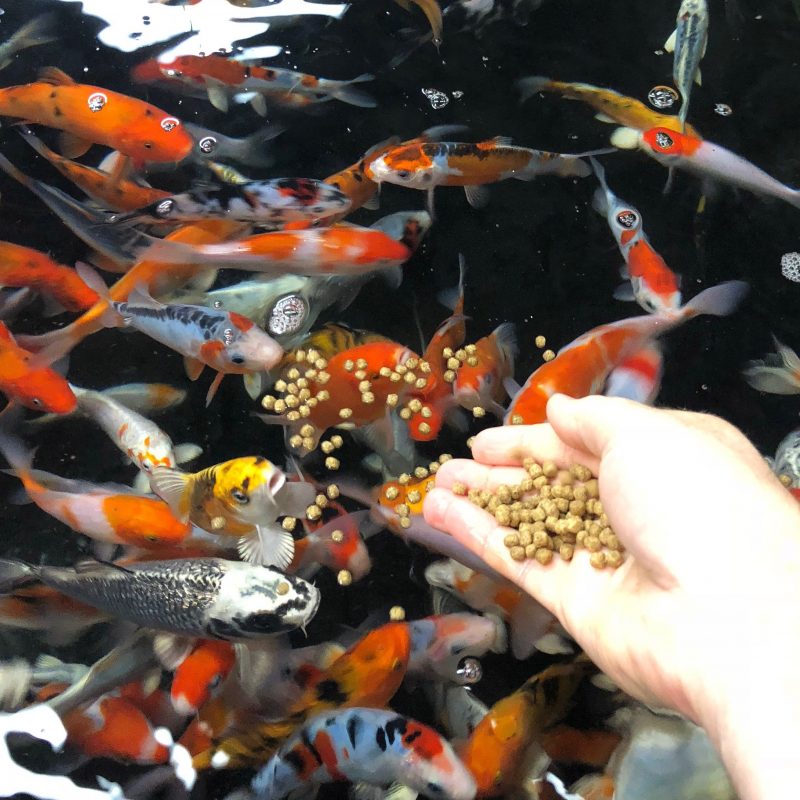Feeding time is a huge part of the bonding experience between koi and their keepers. During this time, koi can go from just fish to welcomed companions. However, as easy as feeding time seems to be, here are a few guidelines to keep in mind.
Water Temperature
The water temperature that your koi are swimming in is one of the most important factors to take into consideration when deciding when and how much to feed. Generally, the warmer the water is, the more that koi will eat. This is due to the speed of the koi’s metabolism, which is dictated by the water temperature – the higher it is, the more food the digestive system can process. Alternatively, when water temperatures turn cold, the metabolism slows down and the digestive system cannot move as much food. This is important to remember, as uneaten food that sits too long in the gut can turn toxic and become fatal!
Here is a general guideline to use for feeding schedules after you have measured your water temperature:
70-85 degrees F – 2 to 4 times daily
60-70 degrees F – 1 to 2 times daily
50-60 degrees F – 1 to 2 times daily of low-protein diet
40-50 degrees F – once daily of low-protein diet
Below 40 degrees F – stop feeding
Keep in mind that these suggestions are not rigid rules – the most important thing is to listen to the actions of your koi. You may need to alter this schedule based on your particular situation.
Uneaten Food
Your koi should be able to get their fill after about 3 to 5 minutes of feeding. Afterwards, any uneaten food pellets that remain in the pond will need to be removed. If not, the oils on uneaten food can leech into the pond and degrade the water quality. You can sometimes notice this when there is a hazy appearance to the water clarity after feeding. Also, uneaten pellets can accumulate on the bottom of your pond or aquarium in the form of a sludge or sediment. This protein sludge can also provide nourishment for harmful bacteria to flourish, so be prepared to stop this build up by removing uneaten pellets that are floating around.
Floating Vs. Sinking Pellet
Floating pellet food seems to be the most common diet for koi, as it brings them towards the surface and provides a much better view of the color and patterns! However, that does not mean that sinking pellet does not have its own merits. Newly arrived koi that have just moved in to your pond may be shy about approaching the surface, and this is where sinking pellet can come in by providing them with food at a more comfortable depth. Be careful with using too much sinking pellet, as it can cause your koi to rub against the bottom of your pond or aquarium, opening up the mouth to small cuts that can lead to infection. This is especially true if you have gravel in your pond or aquarium! Here is a link to more information about the differing pellet types.
Koi Anatomy
Did you know that koi do not have stomachs? Food that passes the esophagus simply travels through an intestinal tract, where nutrients are absorbed. Here is a link to a previous blog post, which describes the digestion process in more detail. How quickly food passes through the gut is determined by the strength of the metabolism. When the koi is active and metabolism is high, food passes through quickly and efficiently, allowing for multiple feedings per day. However, when metabolism slows and koi aren’t as active, food will pass through more slowly. In fact, food that is left in the gut when koi go into hibernation will not move it all, eventually rotting and becoming toxic. That is why it is important to pay attention to water temperature, so that you can accurately determine when to stop feeding completely.
Every hobbyist looks forward to their koi racing up to the surface of the pond to greet them. Feeding time should be an enjoyable experience, and with these ideas in mind, we hope you get the best experience possible from your pond!
Do you have any tips to add? Leave a comment below to let others know!


I know it is the end of February and the beginning of March. My water temperature is 50 degrees and my fish are coming up. The oldest is 13 years old and the youngest is 5. I do agree to keep an eye on your fish , they will let you know when they are hungry . For those with new ponds I would suggest to get a thermometer to keep an eye on water thempture .
Thank you Steve, excellent suggestion! A thermometer is a must for any new pond owner.
I inherited a pond with 7 koi when we bought our home 2 years ago. They swim away as I approach the ponds edge. How do I get them to want to come towards me and near me when it’s feeding time. I am Lacking the hopeful bond between keeper and fish. Any advice is welcome.